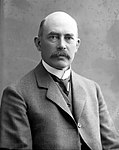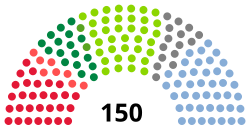From Wikipedia, the free encyclopedia
1921 Norwegian parliamentary election|
|
|
|
|
First party
|
Second party
|
Third party
|
|
|
|

|

|
| Leader
|
Otto Bahr Halvorsen
|
Gunnar Knudsen
|
Kyrre Grepp
|
| Party
|
Conservative
|
Liberal
|
Labour
|
| Last election
|
40 seats, 30.4%
|
51 seats, 28.3%
|
18 seats, 31.6%
|
| Seats won
|
42
|
37
|
29
|
| Seat change
|
 2 2
|
 14 14
|
 11 11
|
| Popular vote
|
301,372 (H+FV)
|
181,989
|
192,616
|
| Percentage
|
33.3% (H+FV)
|
20.1%
|
21.3%
|
|
|
|
Fourth party
|
Fifth party
|
Sixth party
|
|
|
|

|

|
| Leader
|
|
Bernt Holtsmark
|
?
|
| Party
|
Farmers'
|
Free-minded
|
Social Democratic Labour
|
| Last election
|
3 seats, 4.7%
|
10 seats with H
|
New
|
| Seats won
|
17
|
15
|
8
|
| Seat change
|
 14 14
|
 5 5
|
 8 8
|
| Popular vote
|
118,657
|
Alliance with H
|
83,629
|
| Percentage
|
13.1%
|
—
|
9.2%
|
|
|
|
Seventh party
|
|
|
|
|
|
| Leader
|
?
|
|
| Party
|
Radical People's
|
|
| Last election
|
3 seats, 3.3%
|
|
| Seats won
|
2
|
|
| Seat change
|
 1 1
|
|
| Popular vote
|
22,970
|
|
| Percentage
|
2.5%
|
|
|
Prime Minister before election
Otto Albert Blehr
Liberal
|
Prime Minister after election
Otto Albert Blehr
Liberal
| |
Parliamentary elections were held in Norway on 24 October 1921.[1] This was the first election to use proportional representation, which replaced previous two round system.[2] The result was a victory for the Conservative Party-Free-minded Liberal Party alliance, which won 57 of the 150 seats in the Storting.
Results[]

|
| Party
|
Votes
|
%
|
Seats
|
+/–
|
| Conservative Party |
301,372 |
33.3 |
42 |
+2
|
| Free-minded Liberal Party |
15 |
+5
|
| Labour Party |
192,616 |
21.3 |
29 |
+11
|
| Liberal Party |
181,989 |
20.1 |
37 |
–14
|
| Farmers' Party |
118,657 |
13.1 |
17 |
+14
|
| Social Democratic Labour Party |
83,629 |
9.2 |
8 |
New
|
| Radical People's Party |
22,970 |
2.5 |
2 |
–1
|
| Other parties |
2,811 |
0.3 |
0 |
–
|
| Wild votes |
655 |
0.1 |
– |
–
|
| Invalid/blank votes |
13,037 |
– |
– |
–
|
| Total |
904,699 |
100 |
150 |
+24
|
| Registered voters/turnout |
1,351,183 |
67.9 |
– |
–
|
| Source: Nohlen & Stöver
|
References[]
Categories:
- General elections in Norway
- 1920s elections in Norway
- 1921 elections in Europe
- 1921 in Norway
- October 1921 events




